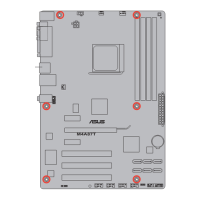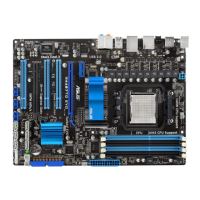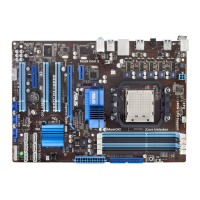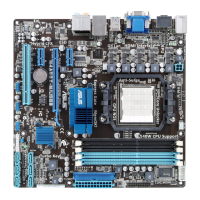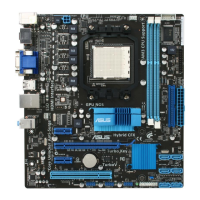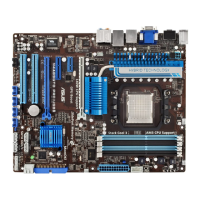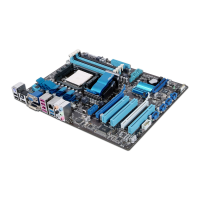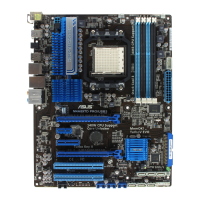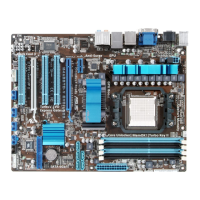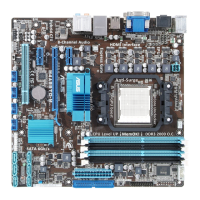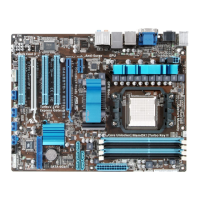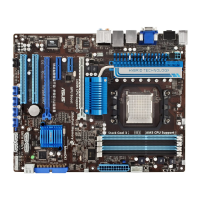Do you have a question about the Asus M4A87T PLUS and is the answer not in the manual?
Information on obtaining source code for licensed software.
Essential safety and preparation steps before installation.
Details on motherboard components, layout, and connectors.
Instructions for installing CPU, memory, and expansion cards.
Information on jumpers, ports, and software installation.
Device compliance with radio frequency and communication regulations.
Chemical substance compliance and product disposal guidelines.
Guidelines for safe handling, installation, and operation.
Explanation of the manual's organization and scope.
Explanation of symbols, text formatting, and navigation cues.
Resources for product and software updates.
Procedures for backing up, updating, and recovering BIOS.
How to enter and navigate the BIOS setup utility.
Methods to access BIOS at startup or after POST.
Explanation of BIOS menu structure and controls.
Explanation of BIOS interface elements like items, fields, and pop-ups.
Basic system configuration for time, date, and SATA devices.
Configuration options for SATA ports like IDE, RAID, AHCI.
Overview of detected system specifications.
Settings related to CPU features and performance.
Configuration for DRAM controller and NorthBridge features.
Configuration for onboard audio, LAN, and front panel select.
Configuration for PCI/PnP devices, IRQ, and DMA.
Settings for USB functions, controllers, and legacy support.
System power management settings including suspend modes.
Advanced power management features like wake events.
CPU temperature, fan speed, and voltage monitoring settings.
Configuring boot order and startup behavior.
Setting boot order and startup speed.
Setting supervisor/user passwords and access restrictions.
Utilities for BIOS management like EZ Flash and O.C. Profiles.
Managing BIOS changes, saving, discarding, and loading defaults.
Product regulatory compliance statements.
Additional compliance details and CE marking information.
Information on obtaining source code for licensed software.
Essential safety and preparation steps before installation.
Details on motherboard components, layout, and connectors.
Instructions for installing CPU, memory, and expansion cards.
Information on jumpers, ports, and software installation.
Device compliance with radio frequency and communication regulations.
Chemical substance compliance and product disposal guidelines.
Guidelines for safe handling, installation, and operation.
Explanation of the manual's organization and scope.
Explanation of symbols, text formatting, and navigation cues.
Resources for product and software updates.
Procedures for backing up, updating, and recovering BIOS.
How to enter and navigate the BIOS setup utility.
Methods to access BIOS at startup or after POST.
Explanation of BIOS menu structure and controls.
Explanation of BIOS interface elements like items, fields, and pop-ups.
Basic system configuration for time, date, and SATA devices.
Configuration options for SATA ports like IDE, RAID, AHCI.
Overview of detected system specifications.
Settings related to CPU features and performance.
Configuration for DRAM controller and NorthBridge features.
Configuration for onboard audio, LAN, and front panel select.
Configuration for PCI/PnP devices, IRQ, and DMA.
Settings for USB functions, controllers, and legacy support.
System power management settings including suspend modes.
Advanced power management features like wake events.
CPU temperature, fan speed, and voltage monitoring settings.
Configuring boot order and startup behavior.
Setting boot order and startup speed.
Setting supervisor/user passwords and access restrictions.
Utilities for BIOS management like EZ Flash and O.C. Profiles.
Managing BIOS changes, saving, discarding, and loading defaults.
Product regulatory compliance statements.
Additional compliance details and CE marking information.
| Socket | AM3 |
|---|---|
| Chipset | AMD 870 |
| Form Factor | ATX |
| Memory Slots | 4 |
| Max Memory | 16GB |
| PCI Express x16 | 1 |
| PCI Express x1 | 2 |
| PCI Slots | 2 |
| SATA 6Gb/s | 6 |
| Memory Standard | DDR3 2000/1333/1066 |
| LAN | Realtek 8111E, 1 x Gigabit LAN |
| Audio | 8-Channel HD Audio |
| RAID Support | 0, 1, 10 |
| USB 2.0 Ports | 12 (6 on back panel, 6 via headers) |
